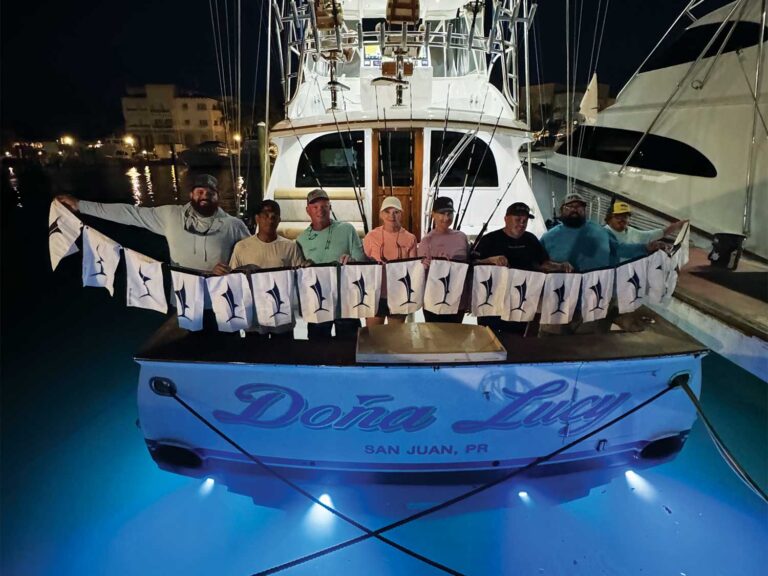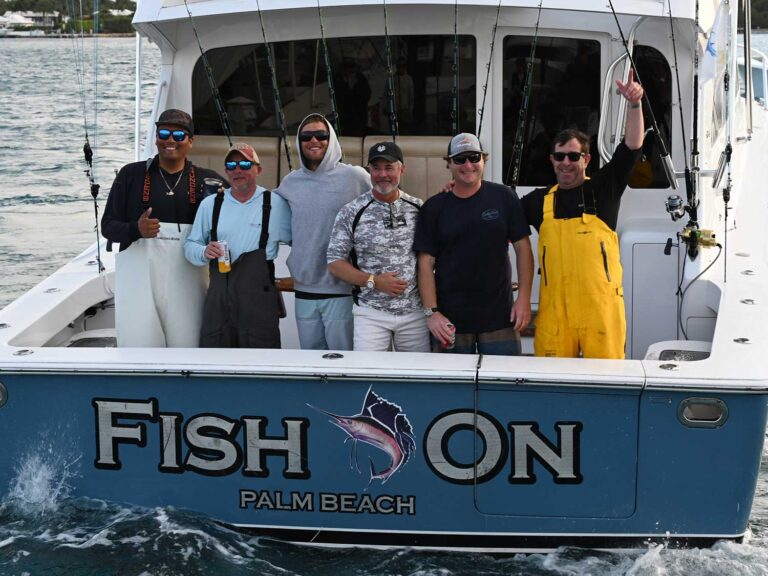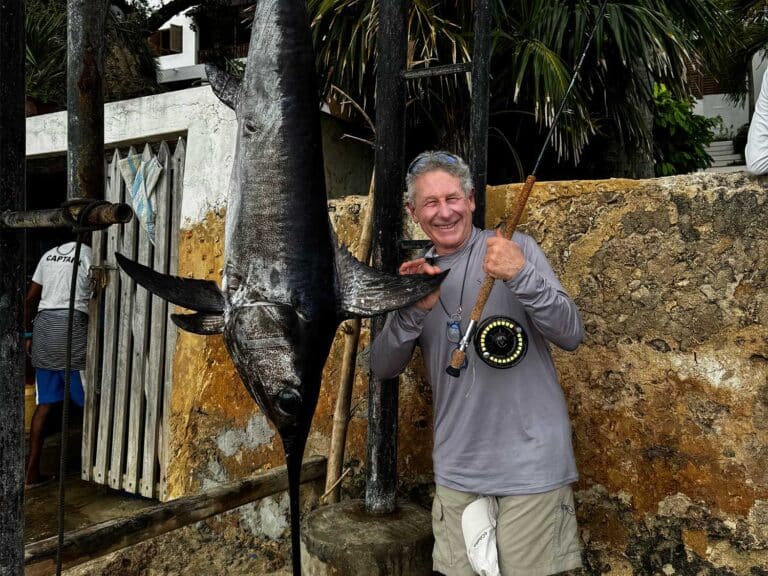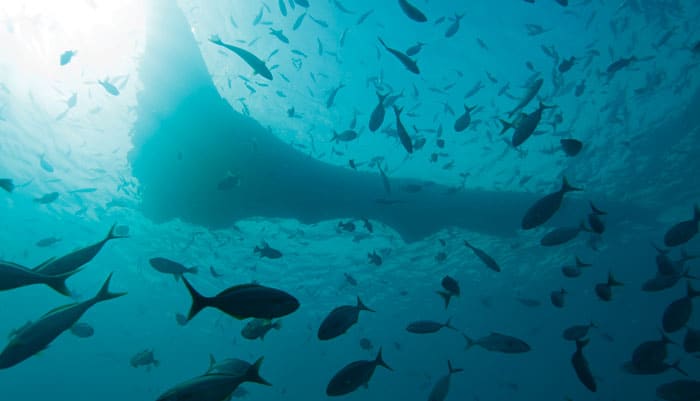
Most of the world’s oceans are filled with vast areas of blue nothingness. The open ocean is more or less a desert in terms of fish per square mile; that’s why the few special places where underwater structures force ocean currents to the surface become such fish havens. Several types of offshore structures hold fish in such large numbers that they are veritable fish factories. One of the most common is the steep canyon, where fish congregate along steep underwater walls that act as underwater fences and stack up bait.
Oceanic seamounts and pinnacles also hold lots of fish, because their vertical hills, mountains and underwater peaks create current upwellings that carry algae- and nutrient-rich water from below to the surface. Solar radiation then triggers algae blooms, which feed the forage species that attract, and become food for, our favorite game fish.
But in the world of fish-attracting features, none is more common, interesting or more productive in terms of aggregating game fish than floating debris, or flotsam. “Flotsam” is a peculiar word that was originally associated with floating pieces of ship wreckage. However, in the sport-fishing world, flotsam is defined as anything found floating in the sea — a common log, a discarded wooden pallet, nets, ropes or rafts of sargassum weed. No matter what the floater is made up of, it still represents a unique opportunity for life to take hold in a really big, empty sea.
After floating at sea for weeks, almost any object begins to form its own ecosystem, which begins to attract fish and other life from all different levels of the food chain. In some parts of the world, fishermen create fish-aggregating, or fish-attracting, devices (FADs) by using anchored trash like pallets, netting and palm fronds to mimic the fish-attracting quality of free-floating debris.
Although the presence of food around debris is certainly one of the main reasons that fish congregate around floating objects, it’s not the only one. Scientists have found that certain fish use objects to help orient themselves in what is otherwise a vast desert of watery terrain lacking any discernible landmarks.
Dr. Kim Holland of the Coconut Island lab of the Hawaii Institute of Marine Biology performed an exhaustive study on small tuna associated with FADs off Oahu, Hawaii. Holland placed radio tracking devices on tuna and followed them for several days. What he found was almost beyond comprehension. The tuna would leave the FAD as the sun got to midmorning levels and go out on forage hunts. They would generally travel as a school and were commonly recorded at distances of up to 14 miles away from the FAD, before returning to the same FAD as darkness fell. These young 1- to 2-year-old tuna made this journey every day.
It’s nearly unimaginable to think that a fish with a brain the size of a pea could leave a floating object in the middle of a vast blue world, go around chasing bait species from the surface to below 500 feet over a 24-hour period (covering an area of many square miles), and then steer themselves right back to their “home” FAD every time. It nearly defies reality, especially given that we as anglers and captains can find a piece of flotsam, mark it on a GPS, note the current speed and direction, move a few miles from the flotsam and never find it again.
As these tuna got bigger (typically above 25 pounds), they tended to move away from the FADs and start a different cycle of life as open-ocean school fish, usually bonding to porpoise schools in a symbiotic feeding relationship. This amazing study by Dr. Holland and his team just scratches the surface of how fish can navigate in their world.
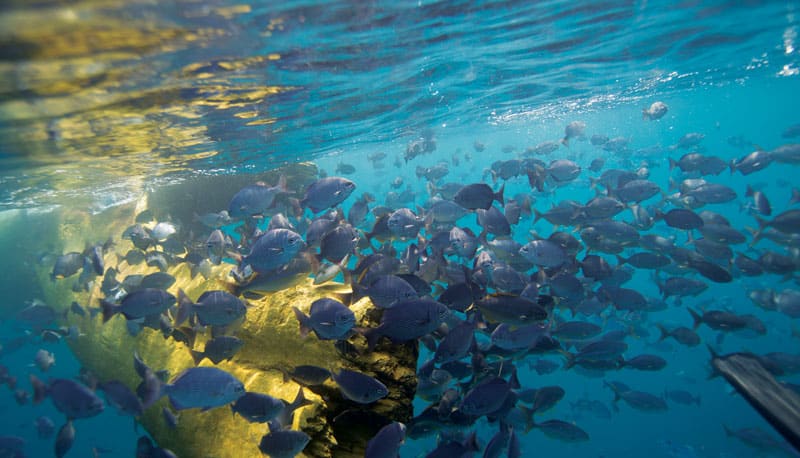
Timing Is Everything
As a rule of thumb, the longer a piece of material floats in the ocean, the more life you’re likely to find around it. But several considerations dictate how many fish — and what kinds — end up staying with the object.
The shape and weight of the floater dictates the speed of its drift. If it’s a new object, floating high in the water, chances are it will drift at a faster speed than a heavy, waterlogged object that sits low and isn’t affected by surface winds. If an object drifts too fast, fish may find it too difficult to keep pace with, and they won’t aggregate in large numbers, whereas most fish can easily keep up with slow-drifting flotsam.
Over time, important bait species find these objects and gather around them for safety, using the flotsam as a shield to hide from predators above and below. Stumbling across a tree trunk submerged in a vertical position should be every offshore angler’s dream! Since they drift at much slower rates, vertical structures tend to acquire bait more quickly and hold it longer. Large, rafting flotsam provides great shade and more protection from bird attacks, but it can move faster over the surface, especially when surface winds and swells work together.
The first items to attach are usually invertebrate fauna, such as gooseneck barnacles. These aid in both slowing the drift speed and creating a food base. Soon thereafter, baitfish such as pelagic triggerfish, cowfish, tripletail, mackerel, small jacks, juvenile dolphin and early-age-class tuna will be seen in the area. Not long after, adult dolphin will circle the debris, along with hammerhead, silky, Galapagos, pelagic whitetip and blue sharks.
Wahoo commonly school around flotsam, and even migratory species like yellowfin, bluefin, bigeye, albacore and skipjack tuna can show up in huge concentrations. Any flotsam holding smaller, schoolie-size tuna is sure to get a visit from a blue or black marlin sometime during the day.
As a fisheries biologist for the Inter-American Tropical Tuna Commission, I worked for 12 years on commercial super tuna seiners in the eastern tropical Pacific. We stopped on every piece of flotsam we crossed paths with to check for fish concentrations. Oftentimes there would be a minimal amount of tuna and we would move on, while other times there would be enough fish to fill a large portion of a 1,200-ton-capacity seiner. The largest “jag” (a net set on a large concentration of fish) I ever witnessed over those years on a piece of flotsam totaled, over a period of a few days, 400 tons of mixed bigeye, yellowfin and oceanic skipjack tuna. Similar tonnage like this may be seen occasionally on structures mentioned earlier, such as submerged canyons, banks and pinnacles, but flotsam differs in that the fish are highly concentrated in an extremely small area, adhering to a floating object sometimes no bigger than an old discarded rope.
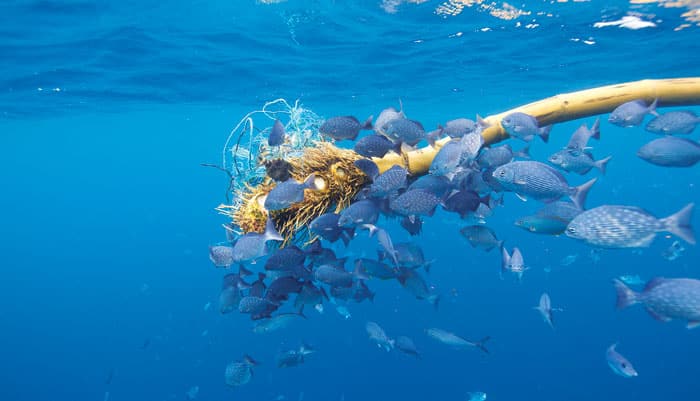
Regional Flotsam
No matter where you fish in the world, you will eventually come across flotsam that’s typified by the area you’re fishing. For example, fishermen on the Atlantic coast from New England to Florida target the huge masses of sargassum weed that follow the Gulf Stream current. The rips and currents spiraling off the Gulf Stream also accumulate other types of debris as well, like wooden pallets, commercial fishing gear and discarded nets. Dolphin use these floating mats of sargassum as feeding stations and points of spatial reference, sometimes sticking with individual mats or pieces of debris for months on end. Of course, wahoo, jacks, tripletail and, occasionally, tuna and marlin tend to investigate these weed and trash lines in search of food as well.
Off the coast of California, where huge forests of kelp grow in abundance, winter storms and large surf help uproot long strands of the brown marine macro algae from their rocky holdfasts and send them offshore to float in tangled masses. These kelp paddies make perfect FADs since they float low in the water, reach deep into the water column and provide abundant cover for baitfish. Here out west, the most common game fish found among the kelp paddies are yellowtail, dorado, albacore tuna, yellowfin tuna and the occasional mako shark.
In the rich water of the eastern tropical Pacific (on the coasts of Mexico, Guatemala, Costa Rica, Panama and Ecuador), much of this tropical coastline gets inundated with flooding rainstorms, which uproot large trees and send them down rivers and into the sea. As these trees become waterlogged, heavy and laden with barnacle growth, they slowly drift and attract a multitude of fish species, such as dorado, jacks, wahoo, skipjack, yellowfin, bigeye, sharks, and blue and black marlin. Huge trash lines of various plastics also form during the rainy season and, as ugly as they are, they usually hold fish as well.
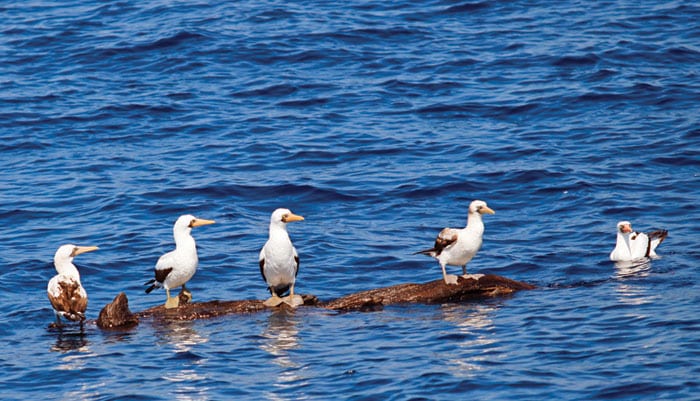
Fishing the Floaters
When offshore, most astute captains and anglers keep their eyes fixed on the horizon, looking for signs of bait or birds. When fish congregate in good numbers under flotsam, there’s a good chance you’ll see birds flying above the action; a few might even be sitting on the floating objects.
Converging currents play an active role in the accumulation of floating debris. As you approach the flotsam, a quick visual survey of the surrounding water with good polarized glasses is helpful as you make a trolling pass. If you have any quantity of live bait on board, throw a few pieces near the flotsam as you pass and watch for fish boiling to eat that offering. Make sure you monitor your fish sounder as well, for the majority of associated fish can be many fathoms below, especially when the sun is high overhead. Early morning, in gray light and throughout the night are when you usually find the densest concentration of fish.
If you see fish working at the surface, the best approach is to position your boat approximately 30 to 50 yards upwind, or up-current of the debris. Let the boat drift back toward the flotsam, and deploy your live baits in the vicinity.
Another way of getting the fish’s attention and bringing them up to the surface is by throwing a loud popper type of plug. Tuna and dolphin love crashing these obnoxious stickbaits, and their commotion often lights up other species as well. With plugs ripping the surface and live baits tugging on the leaders, if anything is home and hungry, it will eat. Don’t stop when you get to the debris; continue to fish the drift until well down-current or downwind, since fish associated with floating debris will commonly wander in the general vicinity and can be encountered a good distance from the log.
Should the sounder mark fish at depth on the initial pass, a logical technique on the next pass would be fishing deep jigs at that depth. Jigs that perform with a great whirling motion upon retrieval and a twirling motion as they sink are always the best choice. It’s quite common to find schooling fish at depths of 100 feet or more around flotsam.
An old trick I use from time to time when dolphin or yellowtail are caught on flotsam is to have a small boat fender rigged as a buoy with 30 feet of 50-pound mono and a hook. I then hook a freshly caught fish to it and immediately release it. These species typically school on flotsam, as they tend to feed in packs. The buoy will give away their position and best tell you where to put the boat on each pass.
So, next time you cross paths with a piece of flotsam, slow down and give it a good working over. These potential fish markets may make your day on the water a more memorable one.

Homemade FAD
Having been there during the true infancy period of the dolphin-safe, tuna-aggregating purse-seine fishery in the eastern tropical Pacific in 1991, I saw firsthand which species were consistently associated with flotsam and FADs and how they behaved over 24-hour periods. This fishery also taught us how quickly fish would associate with a freshly deployed FAD by placing radio frequency “call beeper” buoys to them. These beepers could be detected from more than 500 miles away. We found that in some areas of the equatorial eastern Pacific, north of the Galapagos Islands, the FADs would attract upward of 50 tons of tuna in a matter of weeks.
We also discovered the characteristics shared by the most successful FADs. The best had three distinct attributes that enabled them to rapidly collect fish. The first was a large surface area, be it a wooden pallet or a sheet of plywood with the outer edges tied with tuna cord; the second was deep structure, oftentimes a long strand of discarded net mesh or a few plastic milk crates tied to a length of polypropylene line at various depths. These attachments would immediately begin to culture gooseneck barnacles and act as a sea anchor to slow the drift.
The third thing successful FADs had was a chum barrel — typically an old blue plastic 55-gallon drum with four tuna net floats attached for maximum flotation. The crew further modified the barrel by cutting dozens of 2-inch holes in it and fashioning a lid arrangement on top so it could be filled with 4- to 10-pound whole tuna as the chum. This helped create the building blocks of the food chain. As the tuna scraps were eaten, the small baitfish would use the cavern of the empty drum as their “hideout.”




